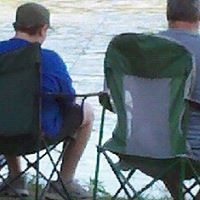William W Silver
age ~64
from Plymouth, MA
- Also known as:
-
- Bill Silver
- Bill Silva
- Silver William
William Silver Phones & Addresses
- Plymouth, MA
- Allston, MA
- Miami Beach, FL
- Edgartown, MA
- Stowe, VT
- Franconia, NH
- New York, NY
Us Patents
-
Apparatus And Method For Detecting And Sub-Pixel Location Of Edges In A Digital Image
view source -
US Patent:6408109, Jun 18, 2002
-
Filed:Oct 7, 1996
-
Appl. No.:08/727721
-
Inventors:William Silver - Weston MA
Arman Garakani - Wellesley MA
Aaron Wallack - Natick MA -
Assignee:Cognex Corporation - Natick MA
-
International Classification:G06K 982
-
US Classification:382300, 382190, 382199, 382266
-
Abstract:The invention provides a fast, computationally inexpensive, and highly accurate method and apparatus for edge detection in a digital image, even for edges that are not substantially parallel to the axes of the pixel grid, by exploiting computationally inexpensive estimates of gradient magnitude and direction. In particular, the method includes the steps of: estimating gradient magnitude and direction at a plurality of regularly-spaced pixel points in the image so as to provide a plurality of estimates of gradient magnitude and direction, each such estimate being associated with a respective gradient point of a regularly-spaced gradient grid; using gradient direction associated with each gradient point to select a respective set of neighboring gradient points; comparing gradient magnitude associated with each gradient point with each gradient magnitude of the respective set of neighboring gradient magnitudes so as to determine which of the gradient magnitudes is a local maximum in approximately the gradient direction; and using the local maximum of gradient magnitude and a set of neighboring gradient magnitudes to determine an interpolated edge position along a one-dimensional gradient magnitude profile. Another aspect of the invention for providing two-dimensional edge position interpolation further includes the step of determining a plane position line normal to the gradient direction of a gradient point associated with the local maximum of gradient magnitude, the plane position line also passing through the interpolated edge position, along which plane position line at least one two-dimensional interpolated position of the edge can be determined.
-
Efficient Flexible Digital Filtering
view source -
US Patent:6457032, Sep 24, 2002
-
Filed:Nov 15, 1997
-
Appl. No.:08/971241
-
Inventors:William Silver - Weston MA
-
Assignee:Cognex Corporation - Natick MA
-
International Classification:G06F 1710
-
US Classification:708315, 708319
-
Abstract:A system is provided for digitally processing a one-dimensional digital signal, including convolving the one-dimensional digital signal with a function that is the (n+1) difference of an n order discrete piecewise polynomial kernel so as to provide a second one-dimensional digital signal. Here, ânâ is at least 1, the polynomial kernel has a plurality of non-zero elements, the function has a plurality of non-zero elements and at least one zero element, and the function has fewer non-zero elements than the polynomial kernel has non-zero elements. Then, the second one-dimensional digital signal is discretely integrated n+1 times. Also, multi-dimensional signals are dimensionally separated and processed using a function for each dimension. In addition to providing parabolic kernels and approximate Gaussian kernels, the invention can provide many other filter shapes, thereby allowing unprecedented flexibility in matching filter specifications to particular signal processing applications, while also providing high computational efficiency.
-
Video Safety Detector With Shadow Elimination
view source -
US Patent:6469734, Oct 22, 2002
-
Filed:Apr 29, 2000
-
Appl. No.:09/563010
-
Inventors:Sanjay Nichani - Natick MA
Robert Wolff - Sherborn MA
William Silver - Weston MA
David A. Schatz - Needham MA -
Assignee:Cognex Corporation - Natick MA
-
International Classification:H04N 718
-
US Classification:348152, 348164
-
Abstract:A two-dimensional (2-D) machine-vision safety-solution involving a method and apparatus for performing high-integrity, high efficiency machine vision. The machine vision safety solution digitally filters a configurable number of time-sequenced images of a viewed area to create a filtered image. A textured background is used as a static target and viewed under ambient light, or alternatively a texture is observed under IR light. An artificial texture can be created with a particularized pattern. Each new image is then compared to the previously created model and a pixel-oriented difference image is calculated. The difference image is then processed for segmentation features attributable to an intruder object. For segmentation results that exceed a predetermined threshold, an alarm condition is set.
-
Machine Vision Methods For Inspection Of Leaded Components
view source -
US Patent:6639624, Oct 28, 2003
-
Filed:Apr 11, 2000
-
Appl. No.:09/547590
-
Inventors:Ivan Bachelder - Newton MA
Karen Roberts - Natick MA
Aaron Wallack - Natick MA
William Silver - Weston MA
Edward Collins - Smithfield RI
Karen Sarachik - Newtonville MA -
Assignee:Cognex Corporation - Natick MA
-
International Classification:H04N 718
-
US Classification:348 87, 348 94, 348 95, 348126, 348129, 348130
-
Abstract:A machine vision method for locating a leaded electronic device, such as integrated circuit chips, includes searching the image with a template depicting only a portionâe. g. , one or two âsideâ edgesâof each of one or more of the leads expected on the device. The template can include portions representing expected leads, as well as unexpected leads or unexpected lead positions. Positive and negative weightings are applied to such portions, as appropriate. A location of the device, or of one or more of its leads, is based on the results of the search.
-
Fast High-Accuracy Multi-Dimensional Pattern Inspection
view source -
US Patent:6658145, Dec 2, 2003
-
Filed:Dec 22, 2000
-
Appl. No.:09/746147
-
Inventors:William Silver - Weston MA
Aaron S. Wallack - Natick MA
Adam Wagman - Framingham MA -
Assignee:Cognex Corporation - Natick MA
-
International Classification:G06K 900
-
US Classification:382149, 382141, 382181, 382190, 382197, 382209, 382276, 348 92, 348125
-
Abstract:A method and apparatus are provided for identifying differences between a stored pattern and a matching image subset, where variations in pattern position, orientation, and size do not give rise to false differences. The invention is also a system for analyzing an object image with respect to a model pattern so as to detect flaws in the object image. The system includes extracting pattern features from the model pattern; generating a vector-valued function using the pattern features to provide a pattern field; extracting image features from the object image; evaluating each image feature, using the pattern field and an n-dimensional transformation that associates image features with pattern features, so as to determine at least one associated feature characteristic; and using at least one feature characteristic to identify at least one flaw in the object image. The invention can find at least two distinct kinds of flaws: missing features, and extra features. The invention provides pattern inspection that is faster and more accurate than any known prior art method by using a stored pattern that represents an ideal example of the object to be found and inspected, and that can be translated, rotated, and scaled to arbitrary precision much faster than digital image re-sampling, and without pixel grid quantization errors.
-
Article Of Manufacture Bearing A Universal Alignment Target
view source -
US Patent:6671049, Dec 30, 2003
-
Filed:Oct 30, 2000
-
Appl. No.:09/699540
-
Inventors:William Silver - Weston MA
-
Assignee:Cognex Corporation - Natick MA
-
International Classification:G01B 1100
-
US Classification:356401, 356400, 356399
-
Abstract:An article of manufacture bearing an alignment target having at least one of the following attributes: it has no significant rotational symmetry; it has no significant orientation self-similarity or size self-similarity; it is not primarily composed of circles, circular arcs, straight lines, or right angles; and it may have other unique attributes. In one embodiment, the specific alignment targets are shapes consisting of at least one âgeneralized polar polygon. â Such a figure will include radial lines, circular arcs, and spiral segments when drawn in the Cartesian plane. In another embodiment, the specific alignment targets are members of a family of âfanâ shapes.
-
Apparatus And Method For Detection And Sub-Pixel Location Of Edges In A Digital Image
view source -
US Patent:6690842, Feb 10, 2004
-
Filed:Apr 2, 2002
-
Appl. No.:10/114357
-
Inventors:William Silver - Weston MA
Arman Garakani - Wellesley MA
Aaron Wallack - Natick MA -
Assignee:Cognex Corporation - Natick MA
-
International Classification:G06L 932
-
US Classification:382300, 382199
-
Abstract:The invention provides a fast, computationally inexpensive, and highly accurate method and apparatus for edge detection in a digital image, even for edges that are not substantially parallel to the axes of the pixel grid, by exploiting computationally inexpensive estimates of gradient magnitude and direction. In particular, the method includes the steps of: estimating gradient magnitude and direction at a plurality of regularly-spaced pixel points in the image so as to provide a plurality of estimates of gradient magnitude and direction, each such estimate being associated with a respective gradient point of a regularly-spaced gradient grid; using gradient direction associated with each gradient point to select a respective set of neighboring gradient points; comparing gradient magnitude associated with each gradient point with each gradient magnitude of the respective set of neighboring gradient magnitudes so as to determine which of the gradient magnitudes is a local maximum in approximately the gradient direction; and using the local maximum of gradient magnitude and a set of neighboring gradient magnitudes to determine an interpolated edge position along a one-dimensional gradient magnitude profile. Another aspect of the invention for providing two-dimensional edge position interpolation further includes the step of determining a plane position line normal to the gradient direction of a gradient point associated with the local maximum of gradient magnitude, the plane position line also passing through the interpolated edge position, along which plane position line at least one two-dimensional interpolated position of the edge can be determined.
-
Method For Rendering Algebraically Defined Two-Dimensional Shapes By Computing Pixel Intensity Using An Edge Model And Signed Distance To The Nearest Boundary
view source -
US Patent:6812933, Nov 2, 2004
-
Filed:Oct 30, 2000
-
Appl. No.:09/699590
-
Inventors:William Silver - Weston MA
-
Assignee:Cognex Technology and Investment - Mt. View CA
-
International Classification:G09G 500
-
US Classification:345619, 345419, 382199, 382203
-
Abstract:A method of accurately rendering algebraically defined shapes that can be used to render alignment targets, or for other purposes, is disclosed. The method can render shapes as a bitmap image for machine vision alignment training, for computer display for human observation, and for computer printout for documentation. The method can aid in rendering targets on the objects to be located by providing input to a computer-aided design (CAD) system, or by directly controlling devices such as laser engravers. The rendering method is fast, extremely accurate, and can handle substantially arbitrary shapes. Targets are defined by a real-valued function of position in the real plane that gives the distance from that position to the nearest point on a target boundary. The function gives distance as a positive value for points inside the figure, and as a negative value for points outside the figure. An edge model is used to map distance to real-valued image intensity.
License Records
William H Silver
License #:
RS094610A - Expired
Category:
Real Estate Commission
Type:
Real Estate Salesperson-Standard
William E Silver
Address:
10 Edgewater Dr 5-G, Coral Gables, FL
Phone:
(305)6655124
License #:
1731 - Expired
Category:
Health Care
Effective Date:
Feb 28, 2008
Expiration Date:
Feb 28, 2008
Type:
Dental
Resumes

William Silver
view source
William Silver
view source
William Silver
view source
William Silver
view sourceLocation:
United States

William Silver
view sourceLocation:
United States
Name / Title
Company / Classification
Phones & Addresses
Director Engineering
Holmed Corp
Mfg Surgical/Medical Instruments Mfg Surgical Appliances/Supplies · Surgical & Medical Instrument Mfg
Mfg Surgical/Medical Instruments Mfg Surgical Appliances/Supplies · Surgical & Medical Instrument Mfg
50 Earls Way, Franklin, MA 02038
40 Norfolk Ave, Easton, MA 02375
(508)2383351, (508)2383807
40 Norfolk Ave, Easton, MA 02375
(508)2383351, (508)2383807
CAR WASH SOLUTIONS LLC
EWW PARTNERS, LTD
President, Director
DR. GERALD I. WERNICK, PA
333 Arthur Godfrey Rd, Miami Beach, FL 33140
333 W 41 St, Miami, FL 33140
6950 N Kendall Dr, Miami, FL
333 W 41 St, Miami, FL 33140
6950 N Kendall Dr, Miami, FL
Medicine Doctors

William E. Silver
view sourceSpecialties:
Facial Plastic Surgery
Work:
Dunwoody Ambulatory Surgery Center
4553 N Shallowford Rd STE 60C, Atlanta, GA 30338
(770)4551983 (phone), (770)4577061 (fax)
4553 N Shallowford Rd STE 60C, Atlanta, GA 30338
(770)4551983 (phone), (770)4577061 (fax)
Education:
Medical School
Medical College of Georgia School of Medicine
Graduated: 1963
Medical College of Georgia School of Medicine
Graduated: 1963
Procedures:
Rhinoplasty
Breast Reconstruction
Breast Reconstruction
Conditions:
Intervertebral Disc Degeneration
Languages:
English
Spanish
Spanish
Description:
Dr. Silver graduated from the Medical College of Georgia School of Medicine in 1963. He works in Atlanta, GA and specializes in Facial Plastic Surgery. Dr. Silver is affiliated with Northside Hospital.

William P. Silver
view sourceSpecialties:
Orthopaedic Surgery, Orthopedic Sports Medicine
Work:
Triangle Orthopedic Associates PA
120 William Penn Plz, Durham, NC 27704
(919)2205255 (phone), (919)2206379 (fax)
Duke University Affil PhysicianJames E Davis Ambulatory Surgical Center
120 E Carver St, Durham, NC 27704
(919)4701000 (phone), (919)4701053 (fax)
120 William Penn Plz, Durham, NC 27704
(919)2205255 (phone), (919)2206379 (fax)
Duke University Affil PhysicianJames E Davis Ambulatory Surgical Center
120 E Carver St, Durham, NC 27704
(919)4701000 (phone), (919)4701053 (fax)
Education:
Medical School
Wake Forest University School of Medicine
Graduated: 1997
Wake Forest University School of Medicine
Graduated: 1997
Procedures:
Arthrocentesis
Carpal Tunnel Decompression
Hip Replacement
Joint Arthroscopy
Knee Arthroscopy
Knee Replacement
Shoulder Arthroscopy
Shoulder Surgery
Carpal Tunnel Decompression
Hip Replacement
Joint Arthroscopy
Knee Arthroscopy
Knee Replacement
Shoulder Arthroscopy
Shoulder Surgery
Conditions:
Fractures, Dislocations, Derangement, and Sprains
Internal Derangement of Knee
Internal Derangement of Knee Cartilage
Internal Derangement of Knee Ligaments
Intervertebral Disc Degeneration
Internal Derangement of Knee
Internal Derangement of Knee Cartilage
Internal Derangement of Knee Ligaments
Intervertebral Disc Degeneration
Languages:
English
Spanish
Spanish
Description:
Dr. Silver graduated from the Wake Forest University School of Medicine in 1997. He works in Durham, NC and 1 other location and specializes in Orthopaedic Surgery and Orthopedic Sports Medicine.

William S. Silver
view sourceSpecialties:
Gastroenterology, Hepatology
Work:
William S Silver MD
2 Medical Park Dr STE 14, West Nyack, NY 10994
(845)3623300 (phone), (845)3628001 (fax)
Silver Tatar & Korenfeld Mds
2 Medical Park Dr STE 14, West Nyack, NY 10994
(845)3623300 (phone), (845)3628001 (fax)
2 Medical Park Dr STE 14, West Nyack, NY 10994
(845)3623300 (phone), (845)3628001 (fax)
Silver Tatar & Korenfeld Mds
2 Medical Park Dr STE 14, West Nyack, NY 10994
(845)3623300 (phone), (845)3628001 (fax)
Education:
Medical School
Universidad Autu00F3noma de Guadalajara, Guadalajara, Jalisco, Mexico
Graduated: 1972
Universidad Autu00F3noma de Guadalajara, Guadalajara, Jalisco, Mexico
Graduated: 1972
Procedures:
Esophageal Dilatation
Sigmoidoscopy
Colonoscopy
Endoscopic Retrograde Cholangiopancreatography (ERCP)
Upper Gastrointestinal Endoscopy
Sigmoidoscopy
Colonoscopy
Endoscopic Retrograde Cholangiopancreatography (ERCP)
Upper Gastrointestinal Endoscopy
Conditions:
Cholelethiasis or Cholecystitis
Gastroesophageal Reflux Disease (GERD)
Hemorrhoids
Intestinal Obstruction
Peptic Ulcer Disease
Gastroesophageal Reflux Disease (GERD)
Hemorrhoids
Intestinal Obstruction
Peptic Ulcer Disease
Languages:
English
Russian
Spanish
Russian
Spanish
Description:
Dr. Silver graduated from the Universidad Autu00F3noma de Guadalajara, Guadalajara, Jalisco, Mexico in 1972. He works in West Nyack, NY and 1 other location and specializes in Gastroenterology and Hepatology. Dr. Silver is affiliated with Good Samaritan Hospital Medical Center, Good Samaritan Regional Medical Center and Nyack Hospital.

William A. Silver
view sourceSpecialties:
Internal Medicine, Cardiovascular Disease
Work:
William A Silver MD
60 Gramercy Park N APT 1M1, New York, NY 10010
(212)6742006 (phone), (212)6741933 (fax)
William A Silver MD
76 Penn St, Brooklyn, NY 11249
(212)6742006 (phone), (212)6741933 (fax)
60 Gramercy Park N APT 1M1, New York, NY 10010
(212)6742006 (phone), (212)6741933 (fax)
William A Silver MD
76 Penn St, Brooklyn, NY 11249
(212)6742006 (phone), (212)6741933 (fax)
Education:
Medical School
The Hebrew Univ, Hadassah Med Sch, Jerusalem, Israel
Graduated: 1970
The Hebrew Univ, Hadassah Med Sch, Jerusalem, Israel
Graduated: 1970
Procedures:
Electrocardiogram (EKG or ECG)
Vaccine Administration
Vaccine Administration
Conditions:
Acute Bronchitis
Acute Myocardial Infarction (AMI)
Acute Sinusitis
Acute Upper Respiratory Tract Infections
Angina Pectoris
Acute Myocardial Infarction (AMI)
Acute Sinusitis
Acute Upper Respiratory Tract Infections
Angina Pectoris
Languages:
English
Spanish
Spanish
Description:
Dr. Silver graduated from the The Hebrew Univ, Hadassah Med Sch, Jerusalem, Israel in 1970. He works in New York, NY and 1 other location and specializes in Internal Medicine and Cardiovascular Disease. Dr. Silver is affiliated with Mount Sinai Beth Israel Brooklyn Medical Center.

William Abraham Silver
view sourceSpecialties:
General Practice
Internal Medicine
Cardiovascular Disease
Cardiology
Internal Medicine
Cardiovascular Disease
Cardiology
Education:
Hebrew University, Hadassah Medical School (1970)
Vehicle Records
-
William Silver
view source -
Address:10 Edgewater Dr APT 5G, Coral Gables, FL 33133
-
VIN:1G6DM57T170147671
-
Make:CADILLAC
-
Model:CTS
-
Year:2007
Myspace
Googleplus

William Silver
Work:
Piedmont Natural Gas - Residential / Commercial Energy Specialist (2001)
Education:
East Carolina University - Industrial Distribution

William Silver
Education:
Binus University - Design Komunikasi Visual (Animasi), SMP - SMA Budi Agung
About:

William Silver

William Silver

William Silver

William Silver

William Silver

William Silver
Work:
Liberty Central Schools
Education:
Union College, Teachers College, Columbia University
Flickr
Plaxo

William Silver
view sourceNew York, N.Y.

william silvers
view source
William Silvers MD
view sourceEnglewood, CO

William E. Silver, DDS-DA...
view sourceMiami, Florida
Classmates

William Silver
view sourceSchools:
Williamsport High School Williamsport IN 1942-1946
Community:
Betty Westfall, Shirley Frodge, Roger Owens

William Silver
view sourceSchools:
Brandeis School Lawrence NY 1947-1951
Community:
Winona Winkler, Gary Dresden, Elsie Anderson, Roy Smith

William Silver
view sourceSchools:
Heritage Middle School Valdese NC 1999-2003
Community:
Al Schwankert

William Silver
view sourceSchools:
McGill University Montreal Kuwait 1952-1956
Community:
Jan Delind, Barbara Wainrib, Irina Perlis, Raymond Mercier, Jean Ballantyne, John Botman, John Beardsworth, Betsy Alexandor, Trudy Gold, Stanley Young

William Silver
view sourceSchools:
Laurel Park Elementary School Brentwood NY 1981-1982, East Junior High School Brentwood NY 1982-1985, Tenth Grade Center Brentwood NY 1986-1987
Community:
Marisol Hunt, Grace Picanso, Koreen Lee, Hillary Schoingart, Margaret Lambruschi, Gilbert Stodolski, Alyson Haviland

Williamsport High School,...
view sourceGraduates:
William Silver (1942-1946),
Robert Cox (1969-1973),
Nancy Walters (1964-1968),
Sharon Lilly (1969-1973),
Loretta Larch (1942-1946),
Rhonda Mcdonald (1965-1969)
Robert Cox (1969-1973),
Nancy Walters (1964-1968),
Sharon Lilly (1969-1973),
Loretta Larch (1942-1946),
Rhonda Mcdonald (1965-1969)

Brandeis School, Lawrence...
view sourceGraduates:
Laurie Teitelbaum (1988-1997),
Laura Katzman (1990-2000),
Rachel Besner (2000-2001),
Amy Lesh (1981-1984),
William Silver (1947-1951),
David Gewertz (1984-1987)
Laura Katzman (1990-2000),
Rachel Besner (2000-2001),
Amy Lesh (1981-1984),
William Silver (1947-1951),
David Gewertz (1984-1987)

Saint Ignatius School, Sa...
view sourceGraduates:
William Silver (1953-1961),
Alexis Taylor (1995-2002),
Linda Masters (1956-1964),
Kristen Andrews (1994-2002)
Alexis Taylor (1995-2002),
Linda Masters (1956-1964),
Kristen Andrews (1994-2002)
Youtube

Silver William
view source
William Silver
view source
Cody William Silver
view source
William Silver
view source
William Silver
view source
Johnathan William Silver
view source
William Earl Silver Sr.
view source
William Lee Silver
view sourceGet Report for William W Silver from Plymouth, MA, age ~64
















